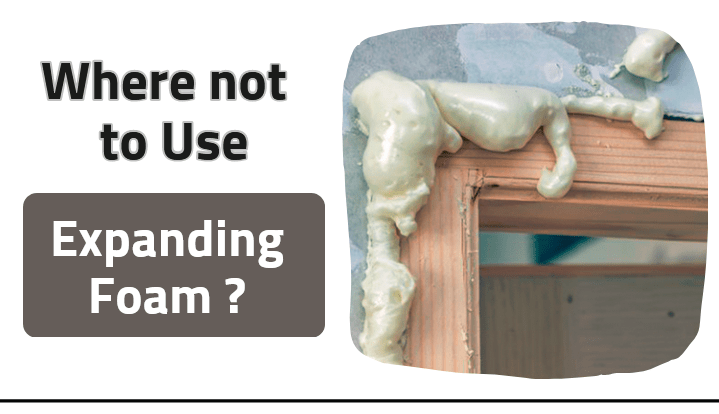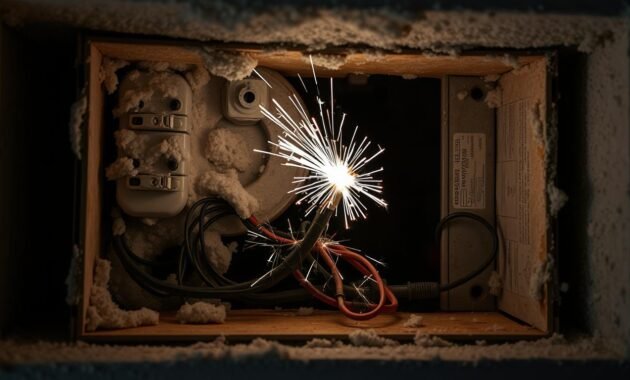Expanding foam is great for many home repairs. But, it’s not for every surface or space. Knowing when not to use it can save you from big mistakes and safety risks.
Many DIY fans have accidentally caused serious issues by using expanding foam where they shouldn’t. It can harm electrical systems and important structural parts. This guide will show you the 8 places to avoid expanding foam.
Learning about these limits helps keep your home safe and makes repairs smarter. Let’s explore the areas where expanding foam is more of a danger than a fix.

Understanding Expanding Foam Properties and Safety Concerns
Closed cell spray foam is a top choice for insulation. It’s powerful and versatile. I’ll share key facts about it, including its properties and safety tips.
Read also: How Do You Get Dried Expanding Foam off
There are many types of expanding foam, each with its own benefits. Let’s explore the main types of foam insulation.
Types of Expanding Foam
- Open-cell foam: Less dense and more flexible
- Closed cell spray foam: Denser and more rigid
- High-density foam: Used for specialized industrial applications
Chemical Composition and Reactions
The type of foam affects its chemical makeup and how it works. Closed cell spray foam has special polymers that make it strong and water-resistant. When you apply it, it expands to fill gaps and seal them tight.
| Foam Type | Density | R-Value | Water Resistance |
|---|---|---|---|
| Open-cell Foam | 0.5-1.0 lbs/ft³ | 3.6-3.8 per inch | Low |
| Closed-cell Foam | 1.8-2.2 lbs/ft³ | 6-7 per inch | High |
Safety Considerations During Application
When working with expanding foam, safety is key. Closed cell spray foam needs special gear and good air flow. Always use:
- Respirator with organic vapor cartridges
- Protective gloves
- Safety glasses
- Full-body protective clothing
Not following safety rules can harm your health and make the foam less effective.
Electrical Boxes and Junction Points: A Dangerous Combination

Expanding foam insulation can be very dangerous around electrical boxes. It’s a risk many homeowners don’t see coming. The main danger is the heat it can cause and the risk of fires.
Electrical wires get hot when they work. Usually, this heat goes away into the air. But expanding foam traps this heat, stopping it from escaping. This can cause wires to overheat, lead to short circuits, increase fire risk, and harm your electrical system.
Using expanding foam near electrical parts is not safe. Electricians say it’s best to keep it away from junction boxes, outlets, and wire connections.
| Electrical Area | Foam Risk Level | Recommended Action |
|---|---|---|
| Junction Boxes | High Risk | Avoid foam completely |
| Electrical Outlets | High Risk | Use approved electrical putty |
| Wire Connections | Extreme Risk | Maintain clear space |
It’s smart to talk to a licensed electrician for safe sealing around electrical areas. Instead of foam, use special putty, foam gaskets, or weatherstripping that won’t hurt your electrical system.
Where Not to Use Expanding Foam: High Heat Areas and Fixtures
Expanding foam is great for many home projects, but it has its limits. It’s not safe for areas that get very hot. This is true for places around heat-producing appliances and fixtures.
Homeowners need to be very careful around heat sources when using expanding foam. Recessed light fixtures are a big problem. Foam can catch fire if it touches hot spots.
Temperature Limitations to Consider
Once it’s dry, expanding foam can catch fire at over 240°F (116°C). This means it’s not good for many places in your home:
- Near furnaces and water heaters
- Around recessed light fixtures
- Close to electrical boxes
- Inside heating ducts
Recommended Safety Distances
| Heat Source | Minimum Safe Distance | Risk Level |
|---|---|---|
| Recessed Light Fixtures | 3 inches minimum | High Risk |
| Furnace | 6 inches minimum | Very High Risk |
| Water Heater | 4 inches minimum | High Risk |
Alternative Solutions for Heat-Prone Areas
For areas that get too hot, look for safer ways to insulate and seal. Use materials like ceramic fire-resistant ones or special heat-resistant sealants. They’re safer than expanding foam near heat.
Always put safety first when using expanding foam. If you’re unsure, get help from a pro. They can show you how to use it right and avoid dangers.
Moisture-Prone Surfaces and Water Exposure Zones

Moisture is a big deal when it comes to expanding foam insulation. I’ve seen how using it in damp places can cause big problems. It’s best to avoid spray foam in areas with a lot of moisture.
When dealing with wet surfaces, expanding foam can be risky. Surfaces with more than 20% moisture are a big challenge. The foam can’t stick well, leading to several issues:
- Poor adhesion to the surface
- Potential mold and mildew growth
- Material degradation over time
- Compromised insulation performance
Before you apply expanding foam, check the moisture level first. Use a moisture meter to get accurate readings. The best surfaces are:
- Clean and dry
- Free from visible water damage
- Below 20% moisture content
In damp areas, you might need something else. Waterproofing or special moisture-blocking materials could work better than expanding foam.
Knowing about these moisture issues can save you from expensive mistakes. It helps make your insulation project more effective.
Structural Components and Load-Bearing Elements
Structural components are key areas to avoid when using expanding foam. It might seem like a quick fix, but it can harm your building’s structure.
I’ve seen many cases where foam application went wrong. The foam’s chemicals can put too much stress on walls, leading to structural problems.
Impact on Building Structural Integrity
Expanding foam can cause big issues in important structural areas:
- Potential warping of load-bearing walls
- Uneven weight distribution
- Reduced structural strength
- Compromised building stability
Proper Alternative Materials
For roof deck and other structural needs, talk to professional contractors. They can suggest good materials. Some reliable options include:
- Rigid foam insulation boards
- Specialized structural sealants
- Professional-grade insulation solutions
- Mechanical fastening systems
Professional Assessment Guidelines
Always get a professional check before making structural changes. Experienced contractors can find the right solution for your building’s needs.
Windows and Doors: Special Considerations
Choosing the right foam for windows and doors is key. Regular foam can warp frames or block doors from opening. This is why special foam is needed.
Low-expansion foam is best for windows and doors. It has several benefits:
- It expands less to avoid warping frames
- It sticks well to different materials
- It insulates better
- It’s safer for the structure
Professionals know not all foams are the same. For windows and doors, precision is important. Low-expansion foam avoids damage by not applying too much pressure.
Always read the instructions and test the foam first. Here’s how to apply it right:
- Clean the area well
- Apply foam in thin layers
- Let it dry between layers
- Trim off excess when dry
Knowing these tips helps homeowners seal windows and doors well. This keeps them working right and looking good.
UV-Exposed Areas and Outdoor Applications
Outdoor applications of expanding foam insulation face special challenges. UV rays can weaken closed cell spray foam, leading to significant damage over time. It’s essential to shield your insulation from sunlight to keep it strong.
I’ve found a few key points to consider for outdoor foam use:
- Direct sunlight exposure breaks down foam polymers
- UV radiation causes material brittleness
- Potential cracking and structural weakening
- Reduced insulation effectiveness
Closed cell spray foam generally holds up better against UV damage than open-cell types. Insulation pros often suggest using protective coatings or extra barriers in sunny spots. It’s wise to talk to insulation experts for the best protection plans.
Read also: Is Spray Foam Insulation Good
There are other ways to insulate outdoors:
- Special UV-resistant foam products
- Protective exterior paint or sealants
- Physical barriers like metal sheeting
- Reflective coating applications
Knowing about these risks helps homeowners choose wisely for outdoor insulation. With the right setup and care, your insulation will last and work well for many years.
Areas Requiring Future Maintenance Access
When you think about using expanding foam, planning is key. Knowing where not to use it can save you a lot of time and money. Some spots need access that expanding foam can block forever.
Expanding foam can be a problem in areas that might need repairs or changes later. This includes plumbing, electrical wiring, and mechanical systems. Foam can make these jobs much harder.
Removal Challenges
Once expanding foam hardens, it’s hard to remove. It sticks to things and is hard to take off without damaging them. Experts often face issues like:
- Foam blocks access to important parts
- Removing it means cutting or breaking things
- Other materials might get damaged when trying to take it out
Planning for Accessibility
To avoid problems with expanding foam, plan carefully. Here are some tips:
- Put up removable barriers around sensitive spots
- Use foam only where it won’t be needed later
- Choose other ways to seal off tricky areas
Alternative Sealing Methods
There are better ways to seal things that won’t make maintenance hard later. Options like silicone sealants, foam backer rods, and special insulation are good. They work well and don’t block access.
| Area | Foam Risk | Recommended Alternative |
|---|---|---|
| Electrical Boxes | Complete blockage | Intumescent fire-rated sealant |
| Plumbing Connections | Permanent obstruction | Flexible silicone gaskets |
| HVAC Pathways | Access limitation | Removable insulation sleeves |
Conclusion: Making Informed Decisions About Expanding Foam Use
Working with expanding foam needs careful thought and planning. Knowing its limits is key to keeping your space safe and avoiding damage. My look into expanding foam safety has shown times when other options might be better.
Getting advice from pros is important when picking insulation. I suggest talking to experts who can check your situation and suggest the best materials. Expanding foam isn’t for everyone, and knowing its limits helps avoid big problems and costly fixes.
The main point is clear: knowing what you’re doing is important. By understanding when expanding foam is good and when it’s not, you can protect your property. This ensures it works well and lasts a long time. Always put safety first, do your homework, and ask for help when you’re not sure about your insulation needs.
Every project is different. Your careful thought about the environment, materials, and risks will decide if your insulation project succeeds. Making smart choices now can save you from big problems later.


